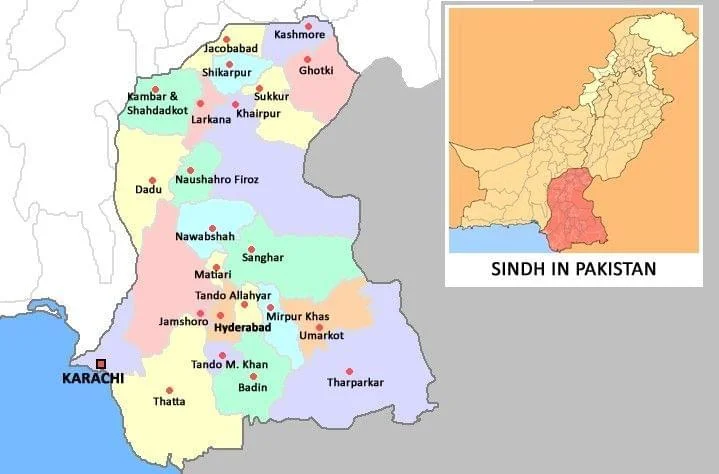Sindh, located in the southeastern part of Pakistan, is renowned for its ancient history and spiritual heritage. The province is home to the ancient city of Mohenjo-Daro, one of the most significant archaeological sites from the Indus Valley Civilization. Karachi, the capital of Sindh, is Pakistan’s largest city and financial hub, known for its bustling port, diverse population, and cosmopolitan lifestyle. Sindh is also famous for its Sufi shrines, such as those of Shah Abdul Latif Bhittai and Lal Shahbaz Qalandar, which attract devotees from across the region.
Karachi:
Karachi (/kəˈrɑːtʃi/; Urdu: کراچی; Sindhi: ڪراچي; IPA: [kəˈraːtʃi] ⓘ) is the capital city of the Pakistani province of Sindh. It is the largest city in Pakistan and the 12th largest in the world, with a population of over 20 million.[12][18] It is situated at the southern tip of the country along the Arabian Sea coast and formerly served as the capital of Pakistan. Ranked as a beta-global city,[19][20] it is Pakistan’s premier industrial and financial centre,[21] with an estimated GDP of over $200 billion (PPP) as of 2021.[16][17] Karachi is a metropolitan city and is considered Pakistan’s most cosmopolitan city, and among the country’s most linguistically, ethnically-, and religiously-diverse regions,[22] as well as one of the country’s most progressive and socially liberal cities.[23][24][25]
The region has been inhabited for millennia,[26] but the city was formally founded as the fortified village of Kolachi as recently as 1729.[27][28] The settlement greatly increased in importance with the arrival of the East India Company in the mid-19th century. British administrators embarked on substantial projects to transform the city into a major seaport, and connect it with the extensive railway network of the Indian subcontinent.[28] At the time of Pakistan’s independence in 1947, the city was the largest in Sindh with an estimated population of 400,000 people.[22] Afterwards, the city experienced a dramatic shift in population and demography with the arrival of hundreds of thousands of Muslim immigrants from India,[29] coupled with an exodus of most of its Hindu residents.[30] The city experienced rapid economic growth following Pakistan’s independence, attracting migrants from throughout the country and other regions in South Asia.[31] According to the 2023 Census of Pakistan, Karachi’s total population was 20.3 million.[32] Karachi is one of the world’s fastest-growing cities,[33] and has significant communities representing almost every ethnic group in Pakistan. Karachi holds more than two million Bengali immigrants, a million Afghan refugees, and up to 400,000 Rohingyas from Myanmar.[34][35][36]
Karachi is now Pakistan’s premier industrial and financial centre. The city has a formal economy estimated to be worth $190 billion as of 2021, which is the largest in the country.[37][38] Karachi collects 35% of Pakistan’s tax revenue,[39] and generates approximately 25% of Pakistan’s entire GDP.[40][41] Approximately 30% of Pakistani industrial output is from Karachi,[42] while Karachi’s ports handle approximately 95% of Pakistan’s foreign trade.[43] Approximately 90% of the multinational corporations and 100% of the banks operating in Pakistan are headquartered in Karachi.[43] It also serves as a transport hub, and contains Pakistan’s two largest seaports, the Port of Karachi and Port Qasim, as well as Pakistan’s busiest airport, Jinnah International Airport.[44] Karachi is also considered to be Pakistan’s fashion capital,[45][46] and has hosted the annual Karachi Fashion Week since 2009.[47][48]
Known as the “City of Lights” in the 1960s and 1970s for its vibrant nightlife,[49] Karachi was beset by sharp ethnic, sectarian, and political conflict in the 1980s with the large-scale arrival of weaponry during the Soviet–Afghan War.[50] The city had become well known for its high rates of violent crime, but recorded crimes sharply decreased following a crackdown operation against criminals, the MQM political party, and Islamist militants, initiated in 2013 by the Pakistan Rangers.[51] As a result of the operation, Karachi dropped from being ranked the world’s 6th-most dangerous city for crime in 2014, to 128th by 2022.[52]
